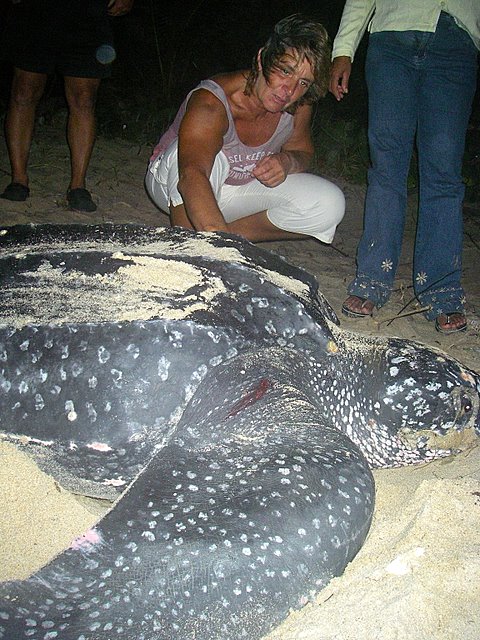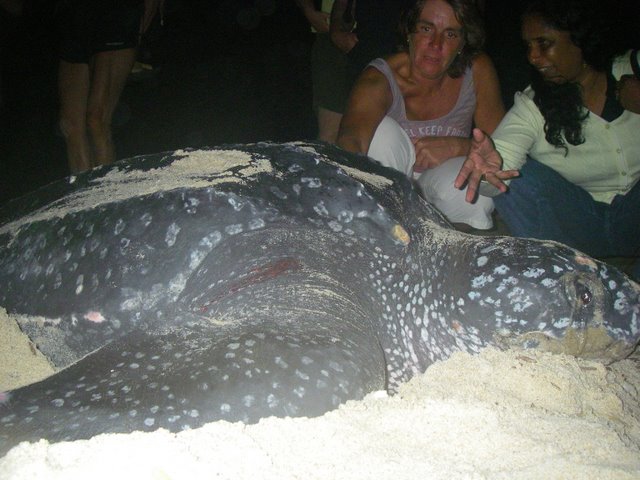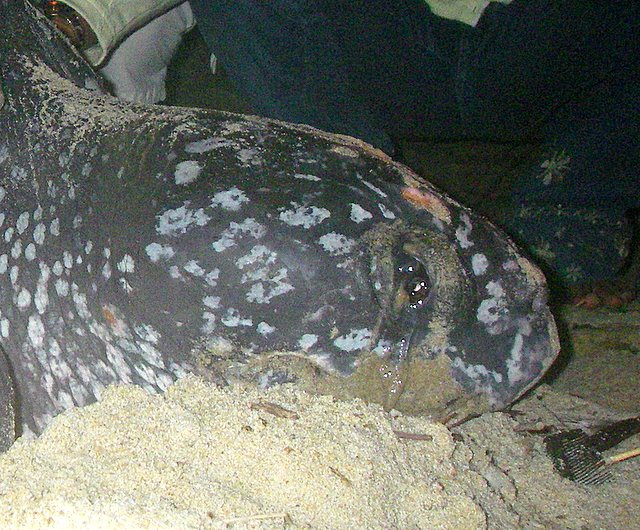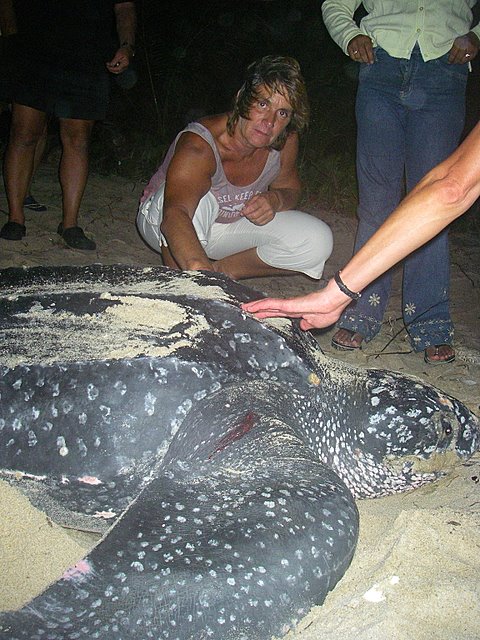Turtle Power

Chaser 2
Yvonne Chapman
Wed 11 Jul 2007 15:29
|
This is a good one.
Jesse James, a local Trinidadian has his own business in the Chaguaramas area
serving only the cruisers. He offers taxi rides, shopping trips, island tours,
turtle watching trips etc. He operates under the name of Members Only, and is
available only to non-members via channel 68 on the VHF. i.e. there is
no membership, that's just his business name. He has a good reputation and
recommended by locals and cruisers alike.
Yvonne and I wanted to see the giant leatherback
turtles, we tried in Tobago with Susie and Billy but they didn't
appear. We booked a trip with Jesse, there were ten people on the trip and
he picked us all up from our various Marinas at 1700hrs. The drive to
Matura beach is about two and a half hours each way, it's on the otherside
of Trinidad and the roads are a little windy and bumpy. Jesse is a great guide
too, non stop talking, explaining all the points of interest and
history along the way. Just outside a village named (appropriately enough
for us) Valencia, he stopped at a Chinese Restaurant for us all to graze on a
very good chicken meal and a drink, which also gave us time to chat to the other
cruisers in the bus. After our fill, back in the minibus, we drove on to
Matura Beach well known for its Turtle invasion during the March to August
season.
On our arrival we were met by a guide, this is quite a
controlled environment, nobody is permitted on the beach, day or night during
turtle season without a permit that you must prearrange. Anton, our guide
explained the do's and don'ts on the beach, and most people respected his
authority. Cameras, flashes, torches must not be used at any time other than
when the guide gives his permission.
As we arrived on the beach a giant Leatherback turtle
arrived as if she timed her visit for us. The waves were big and it was a
dark but clear night. We could see her silhouette struggling out of the
surf, and slowly clawed her way up the soft sand of the beach. Any lights or
flashes now could make her turn back to the Ocean in search for another site, so
we all stood still waiting for a to choose her nesting site. With her
giant flippers she clawed her way towards us, in fact we had to move back
because she kept on coming, waiting to sense the correct site to lay her
eggs. She is looking for sand soft enough to dig, warm enough to incubate
the eggs and far enough from the high water line. The sand is cooler nearer the
high-water line and warmer nearer the vegetation, this decides the sex of the
babies. In the cooler sand the babies tend to be male and the warmer sand
female.
Our turtle clawed her way forward, groaning as she did
so until she found her spot. She then makes a nest scraping away the soft
sand until her body is down on firm sand, she then throws some sand over her
body so as to camouflage herself as much as possible. With her large back
flippers she starts to dig, as much as 2 feet deep depending on the size of her
flippers, but as far down as she can reach. Each slow deliberate move scoops out
sand and at the same time moves her flipper in a circular motion to try and make
the wall of the hole firm so as to avoid caving in. When the hole is deep enough
she then widens the bottom of it so the eggs when laid are not all on top of
each other filling the egg nest to the top.
The process of excavation can take a long time maybe an
hour if the sand is too soft or a child kicks some sand back in the hole.
In fact our turtle couldn't find good sand, it was too soft, and under the
weight of her giant body, maybe 1000lbs, the sand kept falling back into the
pit, despite attempts by our guide and Jesse to help her dig. She therefore
aborted that attempt, struggled back up, covering the hole before moving on
to find another location. Only a couple of metres away she tried again, and
this time was successful. Our turtle then stopped moving, she enters almost
trance like condition whilst laying her eggs (up to one hundred). At this time
we are allowed to take photos and moved around to her head. She looks to being
crying as she lay there depositing her eggs into the nest, she groans and
breathes heavily until egg laying is over until the next time. During
the season, she'll return to that beach perhaps six or seven times to
lay a hundred or more eggs, at the end of the season she'll leave and not
return for three years. Maybe this was her last
effort this season, but being near the end of the season, hatchlings are now
showing them themselves and fortunately we saw a few coming to the surface and
scurrying down the beach.
This is another reason why strict control is carried
out on the beach, because the babies get confused. Their method of finding the
water is by light, the vegetation behind the beach is dark and the ocean and
surf sparkles in the light of the moon and stars, any lights or torches on the
beach at this time and the poor babies don't know which way to turn. On the
tummy of these babies, the egg sack is still attached, nature allows this so as
to give them food on their swim out into deep water, avoiding the need for them
to stop and feed in the shallows where they are taken by birds or predatory
fish, apparently only one or two out of a thousand survive to be adults to
return twenty five years later. We're told also these babies sometimes make the
mistake of digging their way to the surface during daylight hours, maybe because
it's a dark stormy day, a lot of rain maybe cooled the sand leading them
to believe night has arrived. Seabirds, Vultures line the beach as if on parade
waiting for the tasty, easy to grab morsels.
We left our turtle to cover her eggs, compact the sand
using her large rear flippers and all her body weight, so as anyone walking over
the nest doesn't damage these soft skinned, golf ball sized eggs. She then
moves around the whole nesting area spreading and throwing sand to camouflage
the area as much as possible before making her way, exhausted, back to the
sea.
The tears you can see in the photos are not tears of
joy or pain though it makes a good story. Our guide tells us that their staple
diet is jelly fish which have a very high salt content. These turtle have it
appears some kind of built in desalinization plant which allows the excess salt
water to be excreted from the eyes. This happens day and night in the water or
out of it.
Sometimes as many as two hundred turtles arrive during
one night on this beach, literally bumping in to each other.
Our thanks goes to Jesse James and our guide Anton who
made the experience even more enlightening.
This tour cost 225 TT$ per person, approx 18 pounds or
25 euros, includes permits and our evening meal, how bads that?
The last photo is of Big Nose the resident Pelican on
our mooring post. Photo by Yvonne!
Who you callin' Big Nose?
|





